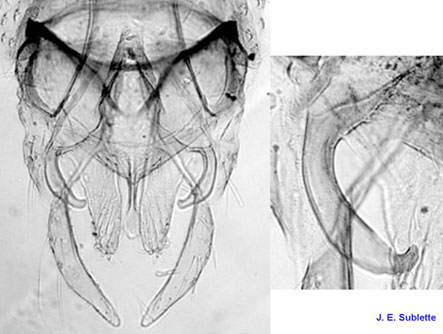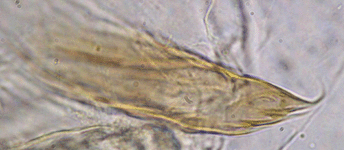Species 2n. C. quinnitukqut Martin, Sublette & CaldwellC. halophilus Packard 1873 could be the senior synonym for this species (see also C. sp. Cape Cod)This species is in BOLD Bin: BOLD:AAB7030
C. 'butleri' and C. quinnitukqut are also in this Bin.Adult
Male identified by Townes as C. atrella, to which the species will key in his 1945 key.Male:
Wing length 3.70 (2.96-4.31) mm; 36 (21-43) setae on squamal fringe; VR about 1. LR 1.16 (1.14-1.22); BR 6.33 (5.71-7.16)
Head, thorax, including most of antepronotum and scutellum paler yellowish; thoracic vittae, postnotum, legs and abdomen largely blackish.
Head - AR 3.57 (3.41-4.70); frontal tubercles 30 (25-42) µm; about 1.7 times longer than wide; clypeal width about the same as width of antennal pedicel; clypeal setae 38 (24-56); palpal proportions (segs. 2-5) (µm) 75 : 70 : 203 : 189 : 224.
Thoracic setae - Acrostichals present but not counted; Dorsolateral 29 (25-42) in a single to mostly triple row; prealar 7 (6-7); scutellar 26 (22-42) mostly in a single slightly staggered row laterally becoming double at medial apex.  6 (2-7) setae in individual pale spots on tergite IX; anal point narrows gently to distal end; Superior volsella of the E(i)-type of Strenzke (1959); Inferior volsella narrowing towards the tip, longer than anal point, reaching to about the midpoint of the gonostylus, which is only moderately broad and narrowing gently over posterior third. Female:
Wing length 3.61 mm; 38 setae on squamal fringe; VR 1.12. LR 1.24.
Color similar to male but paler abdominal incisures slightly more pronounced.Antennal proportions: 150 : 85 : 85 : 105 : 270; AR 0.64. A5/A1 1.8.
Palpal proportions (segs. 2-5)(µm) 75 : 210 : 190 : 240; about 38 clypeal setae.
Thoracic setae: Acrostichal not counted; Dorsolaterals (including humerals) 41 extending anteriorly to near the antepronotum; Prealar 7; Scutellar 38. Pupa: No pupae were present in our samples, but some pupal characters were visible from a late prepupa. The caudolateral spur has about three spines, progessively along the outer edge, in the available specimen. About 115 setae, multilayered, on each side of anal fringe.
 Fourth instar larva a small to medium sized bathophilus-type, length about 12.1 (11.2-13.2) mm; anterior ventral tubules 0.61 (0.38-1.04) mm, longer than the posterior pair 0.49 (0.28-0.96) mm. Anal tubules relatively short but varying between localities, longer at Truro; ventral pair usually slightly longer (mean 364.3 µm c.f. 325.7 µm) but about the same width; however they can vary from about half as long as wide up to twice as long as wide.
Gular region slightly dark to dark, usually covering most of the gula and widest at the posterior edge; frontoclypeus pale but sometimes with slightly dark lines alongside it or around the antennal base. Oesophageal opening about 68.7 (63-76) µm wide and 3.03 (2.17-4.15) times longer than deep.
Mentum (Fig. d) with somewhat rounded teeth; c1 tooth broad and relatively tall, c2 teeth may be little more than notches (type IB) or may be better developed (IIA - as in figure); fourth laterals sometimes only slightly reduced but more usually reduced to just above the fifth laterals (type i-II); sixth laterals often arising lower than other laterals.
Ventromental plates (Fig. e) with a smooth anterior margin and about 208.1 (197-219) µm wide and 3.4-3.8 times wider than deep; with 41.7 (38-46) striae; VMR about 0.26 (0.22-0.30). Premandible (Fig. a) with broad inner tooth 3-6 times wider than the sharp rapidly narrowing outer tooth - an extreme version of type B2.
Pecten epipharyngis (Fig. c) with about 15.4 (11-18) sometimes irregular teeth but basically type B.
Antenna (Fig. b) with basal segment moderately long(39-44% of the VHL); about 2.6 (2.0-3.2) times longer than wide; RO abt 1/3 to 1/2 way up from base of segment; AR 2.14 (1.85-2.60); antennal segments (µm): 109 : 24 : 7 : 13 : 7 : i.e. A5 close to, or as long as, A3 (A5/A3 = 0.95 (0.82-1.20)).
Distance between antennal bases on average (160.7 µm) larger than that between the S4 setae (158.9 µm), but reversed in about 40% of individuals; S4 setae separated by 0.79-0.87 of the FC width at that point; S5 setae usually level with the nearby RO, but may occasionally be slightly anterior to it.
Mandible (Fig. f) about 253.2 (247-264) µm long, with third inner tooth relatively well developed and almost completely separated, but not as darkly colored as the other teeth (type II-IIIB), with about 14.5 (12-18) furrows on the outer surface at base; 12.8 (10-15) taeniae in Pecten mandibularis; Mdt-Mat 26.4 (20-28) Ám; MTR about 0.31 (0.29-0.35). Cytology: 4 polytene chromosomes with the thummi arm combination AB, CD, EF, G. Keyl pattern difficult to recognise particularly for chromosome AB, where the characteristic bands (groups 24 to 27) of arm B are away from the centromere and the "olive" (groups 6 and 7) of arm A is not obvious.
In the CD chromosome, arm D is relatively shorter than arm C, as the result of a fixed asymmetrical pericentric inversion which moves band groups D24-21 into arm C, while only group C22 is added to arm D.
Arm G may be fully paired, but is usually unpaired towards the sub-terminal nucleolus; a central Balbiani ring and one near the other end. A nucleolus is sometimes developed about 1/3 from distal end of arm B.
Polymorphic in arms A, C, D, E, F and G: polymorphism in C is small and terminal; apparently 3 sequences in arm D, one of which appears to be complex.
qutA1:
qutA2: Some distal homology to A1 of C. decorus (sp. 3a)
qutB1: Characteristic bands (24-27) towards the middle of the arm; nucleolus, when present, immediately distal of these bands.
qutC1: 1 - 2e, 12b, 6b - 2f, 12c, ? - ? 21 (D)21 - 24
qutC2: 1 - 2e, qutD1:
qutD2: Simple inversion of distal half of the arm.
qutE1: possibly 1 - 3e, 10b - 5, 11b - 4, 11c - 13 i.e. inv. 4-11b from uliginosus, etc.
qutE2: possibly 1 - 2c, 5 - 8, 3e - 2d, 11b - 10c. 3f-4, 11c - 13
qutF1:
qutF2:
qutG1: subterminal nucleolus and posterior BR
qutG2: small simple inversion of the region around the distal BR Found: Connecticut – South Cove, Old Saybrook, Middlesex Co.
Massachusetts – East Harbor (Truro), Cape Cod National Seashore, Barnstable Co.
Michigan - western Lake Erie (Failla et al. 2015 Tidal mud flats. Length of ventral and anal tubules appears variable from sample to sample or locality to locality, perhaps dependent upon the salinity or other environmental factors at the time. At Truro it was found with an apparently related species C. sp. Cape Cod (sp. 4k). DNA sequence: Sequence for the mtCOI gene has been obtained from these samples and also from GenBank (access.no. HQ979113, HQ979133). These indicate that this species is closely related to C. 'butleri': and C.decorus with all three species in the same BOLD bin. Comparison of the sequences indicates C. quinnitukqut differs at 13 bases (with 3 of these including a low level of polymorphism for the base in the other species). Base
C. quinnitukqut
G A T T A/T G C T A A T T C
C. 'butleri'
A G C C A T T C G G C/T C A/T Perhaps arising as a result of adaptation to eustuarine waters. This species was identified as C. atrella by Townes and Roback (Hitchcock & Anderson, 1968), but is cytologically quite distinct from other C. atrella populations. In general the cytology suggests it is a member of the C. decorus-group, with similarities to C. decorus (Sp. 3a) and C. sp. Cape Cod.
The biology was described by Anderson & Hitchcock (1968). Described as C. quinnitukqut by Martin et al. (2010), including description of the polytene chromosomes. [ Return to Index | Go to References ] |

